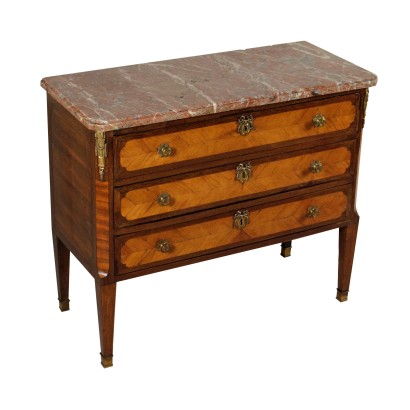Neoclassic Chest of Drawers
Features
Style: Neo-Classical (1765-1790)
Age: 18th Century / 1701 - 1800
Year: Ultimo quarto '700
Origin: France
Main essence: Satinwood , Mahogany , Rosewood
Material: Rosewood Slab
Description
An elegant mahogany chest of drawers, pyramidal feet with brass cups. Three drawers with quadripartite citronnier reserves, uprights with gilded bronze friezes. Marble top, oak interiors. On the top's loose cover there is a label: Montigny Maitre Ebaniste Paris. Manufactured in France, last quarter of the 18th century.
Product Condition:
The item shows signs of wear due to age. Any damage or loss is displayed as completely as possible in the pictures. It may require restoration and polishing.
Dimensions (cm):
Height: 83
Width: 98,5
Depth: 44
Additional Information
Style: Neo-Classical (1765-1790)
This historical period includes a first phase that can be properly defined as the Louis XVI style.
nOnly at a later time, with the maturation of archaeological fashions, was a new vision of furnishing civilization formulated and codified, now fully attributable to the Neoclassical Style.
In fact, both trends coexisted in unison until the last years of the eighteenth century.
nIn the field of cabinet making, the Directoire, Retour d'Egypte, Consular and Empire styles also fall within the neoclassical era.
nFind out more about Neoclassicism with the insights from our blog...
n
Age: 18th Century / 1701 - 1800
18th Century / 1701 - 1800 Main essence:
Satinwood
The name is common in France for citrus limonum , the fruit tree of the lemon. From this plant a light, solid and fragrant wood is obtained, used in the construction of furniture especially in England and France, where it was appreciated for its resistance.
Mahogany
It is one of the most precious and sought-after woods in cabinet making. It was discovered in Central America around 1600 and began to be imported to England in the 1700s. Much appreciated for its hardness and indestructibility, it became widespread following the blocking of walnut exports from France in 1720 and the consequent elimination of English import duties on mahogany from the colonies in America and India. The most valuable version comes from Cuba, but it became very expensive. At the end of the 18th century it began to be used also in France in Louis XVI, Directory and Empire furniture, its diffusion declined starting from when Napoleon, in 1810, forbade its import. It was generally used in the manufacture of elegant furniture, due to its characteristics and beautiful grain.
Rosewood
Under the term Rosewood various exotic, hard and heavy woods have been united, characterized by a color that varies from pink to violet. Their origin is usually from Latin America, India and Africa and are still considered very valuable woods. Until the end of the eighteenth century, this name also referred to the bois de violette . In general, rosewood woods began to be imported into Europe starting in 1750 and were first used for veneers and inlays in England, flanked, by contrast, with lighter woods. Later, entire valuable furniture was manufactured both in England, mainly in the Regency style, and in France, starting from the Neoclassical period.
Material: Rosewood Slab




























